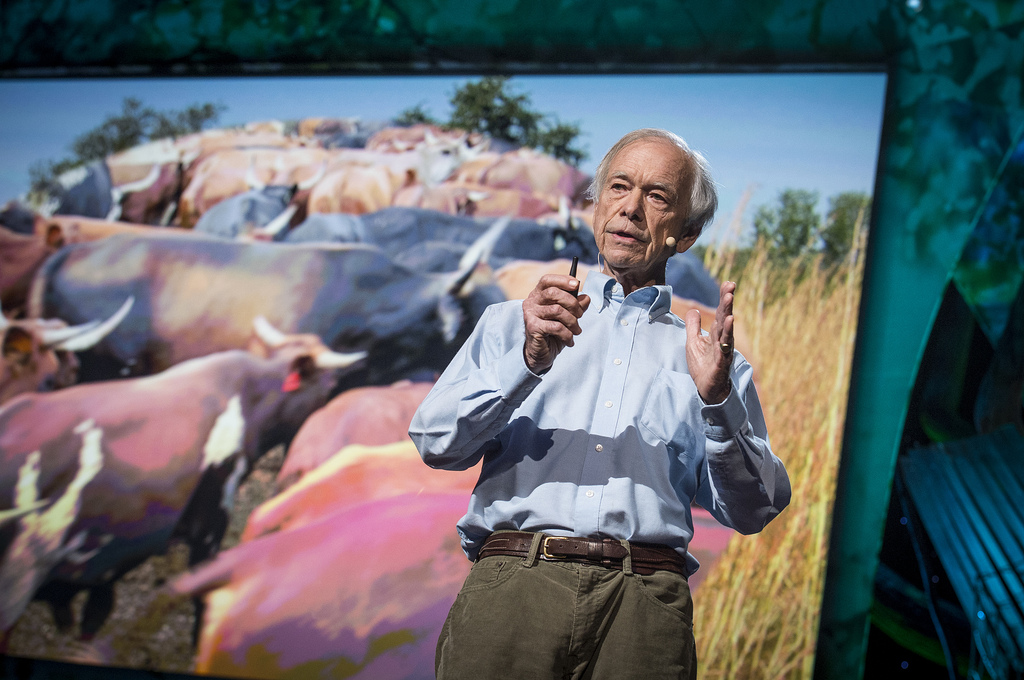
A TED Talk by Allan Savory
and a conversation with Andrew Howley of National Geographic Society
For decades people have pointed to overgrazing by cattle as the main cause of once-fertile grasslands turning to rapidly eroding, nearly lifeless deserts. These desertified landscapes are then incapable of supporting the livestock themselves, agriculture, or large wild animals who once lived in great numbers on the same land. This is leads to famine and conflict in different areas around the world.
Growing up in Kenya, Allan Savory was terribly moved by this. “I grew up loving wildlife and hating livestock,” he said at the TED Conference in Long Beach, California last week (watch his full TED talk in the video above). Two-thirds of the ear
The Pachyderm Paradox
As a young man he thought the blame also lay with an overpopulation of elephants, and so, despite a deep love for these animals, he recommended and supported the culling of large herds. Over the years this practice has resulted in the intentional killing of more than 40,000 elephants, but no real improvement in the health of grasslands.
Realizing what an error he and others had made, Savory confessed, “this was the saddest and gravest mistake of my life.”
“Clearly we have never understood desertification,” he added, “which now threatens us globally.”
A New Vision
Speaking with Allan Savory after his presentation I got some insight into the shift in thinking that occurred next. Our society in general has tended to try to solve problems by breaking them into pieces, isolating elements, and attempting to control complex situations through simple, forced measures. This is all wrong, the way Savory sees it. True, sustainable solutions are found by looking at whole systems, holistically, unconcerned with time, and focused on the restoration of natural balances.
For example, when I asked him (in insistent, fast-paced reporter speech) what I could do if I lived in the southern U.S. and had a field overtaken by invasive kudzu, he said very slowly and calmly, “Well… first… I would say ‘Andrew, what do you want out of this land? For yourself… for your children… for your children’s children…’ ” It was at this point I felt my own high energy settle down, and I understood how much of a shift in attitude Allan’s approach to problem solving in conservation really is.
People tell him he should put rhinos on the land he has restored. But with poor quality land all around, and a lack of value on conservation, people would just come and poach the rhinos for their horns, he said. When the land is restored, and people’s basic needs are met, and an appreciation of wildlife is the norm, then he’s willing to bring rhinos in. Not before. Allan Savory may be in his seventies, but he’s in no rush to force changes.
A holistic view of the problem. A natural source for the solution. Patience. These are the tools Allan Savory works with now.
Cows to the Rescue
So the failure of earlier attempts combined with his estimation that two-thirds of Earth is now desertifying inspired Savory to search for a new approach to protecting and restoring grasslands. And he found it by thinking naturally and looking backward, not forward.
It makes no sense that land that once supported untold millions of grazing animals on massive migrations should be destroyed by the overgrazing of fewer or comparable numbers of livestock in more recent years. And there were areas of the U.S. where cattle had been removed for decades, but the grasslands were still desertifying.
Allan Savory says the key to restoring grasslands is to manage livestock to mimic the role once played by vast migrating herds.
“Clearly we have never understood desertification,” he said. “What we had failed to understand was that these areas developed with huge numbers of grazing animals [pursued by lots of huge carnivores]. Movement kept them from overgrazing.” This way of the past could also hold the key to the future.
“The only option left,” according to Savory, is “to use livestock on the move to mimic the ancient herds.” Keeping cattle more densely packed on smaller plots of land and moving them frequently keeps them from exhausting the supply of living plants, turns scattered droppings into a full blanket of high-quality fertilizer, and keeps the repeated trod of untold tons from packing down the dirt. He’s done it for decades, and the results (seen in the video above) are impressive.
“Holistic grazing” keeps more plants alive, adds nutrients to the soil, and creates soil conditions that hold and use water instead of letting it evaporate or run off. It is now practiced by thousands on five continents, and is the focus of the work of the Africa Centre for Holistic Management in Zimbabwe, as well as the Savory Institute in Boulder, Colorado.
The Bigger Picture
In closing his TED talk, Allan Savory pointed out a critical part of this story beyond preserving complex grassland ecosystems to sustain livestock, agriculture, and wildlife. The amount of plant life lost through desertification over decades has severely compromised Earth’s ability to take carbon dioxide out of the air. Just as we have increased the amount we’re putting into the atmosphere, we’re reducing the amount we take out.
There is a remarkable upside to this however. With all of the difficulties of maintaining a productive economy while reducing our carbon output, and mitigating the effects of a warming climate, if we can implement holistic grazing on half of the Earth’s grasslands, according to Allan, “we can take us back to pre-industrial [CO2] levels… and feed people.”
It would be wrong to think of changing the way we herd cattle as a silver buller that will solve all of Earth and humanity’s challenges, but as a key step in promoting the kind of long-term, holistic view that Allan Savory has taken, it could go a long way towards repairing the land and our relationship to it.
